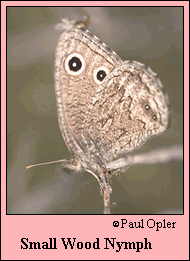 |
 

 |



Small Wood Nymph (Cercyonis oetus [Boisduval])
Wing span: 1 1/4 - 1 3/4 inches (3.2 - 4.5 cm).
Identification: Wings are light to very dark brown; wing fringes are checkered. Upperside of forewing usually has 1 eyespot in the male, 2 eyespots in the female; upper eyespot is larger. Underside of forewing of both sexes has lower eyespot smaller and nearer to the wing edge than the upper eyespot.
Life history: Males patrol all day for females, who deposit eggs singly on the host plant. First-stage caterpillars hibernate unfed until the following spring.
Flight: One brood from June-August.
Caterpillar hosts: Unknown grasses.
Adult food: Flower nectar.
Habitat: Dry chaparral, sagebrush, grasslands, scrub, open woodland, meadows.
Range: British Columbia east to southern Saskatchewan and western North Dakota; south to eastern California, Nevada, central Arizona, and New Mexico.
Conservation: Not usually required.
The Nature Conservancy Global Rank: G5 - Demonstrably secure globally, though it may be quite rare in parts of its range, especially at the periphery.
Management needs: None reported.
References:
Scott, J. A. 1986. The butterflies of North America. Stanford University Press,
Stanford, Calif. 583 pages, 64 color plates.
Tilden, J. W. 1986. A field guide to western butterflies. Houghton-Mifflin Co.,
Boston, Mass. 370 pages, 23 color plates.
Author: Jane M. Struttmann

